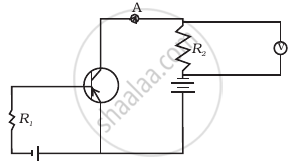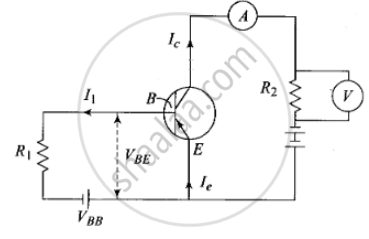Advertisements
Advertisements
प्रश्न
If the resistance R1 is increased (Figure), how will the readings of the ammeter and voltmeter change?

उत्तर
Let us redraw the circuit diagram to find the change in reading of the ammeter and voltmeter.

So, `I_BR_1 + V_(BE) = V_(BB)`
Base current, `I_B = (V_(BB) - V_(BE))/R_1`
`I_B ∝ 1/R_1`
So, R1 is increased, IB is decreased.
Now, the current in the ammeter is collector current IC.
IC = βIB as IB is decreased, IC is also decreased and the reading of the voltmeter and ammeter also decreased.
APPEARS IN
संबंधित प्रश्न
If a small voltage is applied to a p-n junction diode, how will the barrier potential be affected when it is(ii) reveres biased?
State its any ‘two’ uses of photodiode.
Describe, with the help of a circuit diagram, the working of a photodiode.
Briefly explain its working. Draw its V - I characteristics for two different intensities of illumination ?
How does a light emitting diode (LED) work? Give two advantages of LED’s over the conventional incandescent lamps.
Explain the formation of depletion layer and potential barrier in a p−n junction.
Write the important considerations which are to be taken into account while fabricating a p-n junction diode to be used as a Light Emitting Diode (LED). What should be the order of the band gap of an LED, if it is required to emit light in the visible range? Draw a circuit diagram and explain its action.
For LED's to emit light in visible region of electromagnetic light, it should have energy band gap in the range of:
In Figure, assuming the diodes to be ideal ______.

Why a photo-diode is operated in reverse bias whereas the current in the forward bias is much larger than that in the reverse bias? Explain. Mention its two uses.
